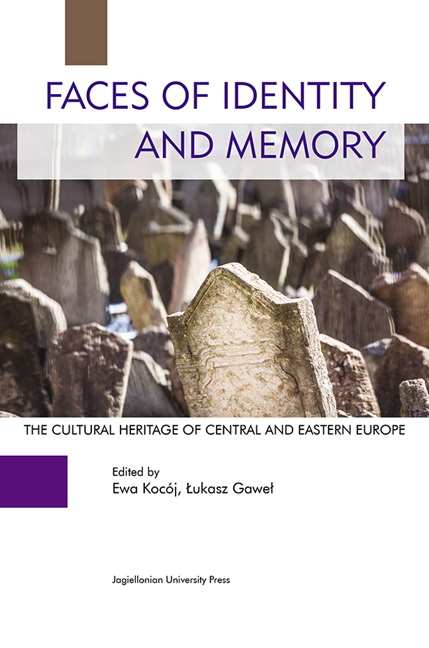 Faces of Identity and Memory
Faces of Identity and Memory Book contents
- Frontmatter
- Contents
- Introduction
- Memory and Identity. Monuments of Romanian Tangible Culture Inscribed on the UNESCO World Heritage List (a Short Presentation)
- Inventorisation and Recording of Sacral Art Objects in Lithuania in 1995–2005
- National lieux de mémoire and the European Heritage Label. Some Reflections on the Case of the Gdańsk Shipyard
- Porrajmos. Constructing Gypsy Holocaust Memory in the Recent Cinema
- The Vacuum and the Imagination of Space. The Cultural Role of the Żyznowski Publishing House
- Cultural Animation as the Art of Remembering. The Activities of the “Borderland of Arts, Cultures and Nations” Centre in Sejny
- ‘The Painted Village’ – Zalipie as an Expression of Ethnographic Tourism in the Powiśle Dąbrowskie Region of Poland
- 20th Century Theatrical Heritage: The Escape from Illusion
- Protection of Cultural Heritage. The Case of Krakow
- Managing an Artist's Legacy on the Example of Foundation for Support of Modjeska's Life and Art Research in Kraków
- Culinary Heritage as Used in the Present. Selected Elements of the Culinary Heritage Management in Contemporary Poland
‘The Painted Village’ – Zalipie as an Expression of Ethnographic Tourism in the Powiśle Dąbrowskie Region of Poland
Published online by Cambridge University Press: 10 January 2018
- Frontmatter
- Contents
- Introduction
- Memory and Identity. Monuments of Romanian Tangible Culture Inscribed on the UNESCO World Heritage List (a Short Presentation)
- Inventorisation and Recording of Sacral Art Objects in Lithuania in 1995–2005
- National lieux de mémoire and the European Heritage Label. Some Reflections on the Case of the Gdańsk Shipyard
- Porrajmos. Constructing Gypsy Holocaust Memory in the Recent Cinema
- The Vacuum and the Imagination of Space. The Cultural Role of the Żyznowski Publishing House
- Cultural Animation as the Art of Remembering. The Activities of the “Borderland of Arts, Cultures and Nations” Centre in Sejny
- ‘The Painted Village’ – Zalipie as an Expression of Ethnographic Tourism in the Powiśle Dąbrowskie Region of Poland
- 20th Century Theatrical Heritage: The Escape from Illusion
- Protection of Cultural Heritage. The Case of Krakow
- Managing an Artist's Legacy on the Example of Foundation for Support of Modjeska's Life and Art Research in Kraków
- Culinary Heritage as Used in the Present. Selected Elements of the Culinary Heritage Management in Contemporary Poland
Summary
Abstract: This paper explains the concept of ethnographic tourism and aims to showcase the tradition and folk culture of South-Eastern Poland, namely the 19th century practice of decorating both the interior and the exterior of buildings and other objects with intricate, floral patterns. It focuses on the village of Zalipie, its history and the genesis of the art form. It also showcases the entire Powiśle Dąbrowskie region as a major ethnographic tourist attraction.
Key words: folk culture, painted village, Zalipie, floral patterns, ethnographical tourism
Preface
Tourism and culture have always been closely related; cultural differences promote the development of tourism, which in turn exposes the general public to different cultures. Cultural tourism aims specifically to showcase the different ways of life of communities around the world, exhibiting their customs, religious beliefs and cultural heritage, all serving the express purpose of satisfying the cultural needs of their people. Amongst the motivations behind cultural tourism and travelling in general, the learning about different folk cultures is steadily raising in prominence.
Folk culture, as used by Bukraba, is defined as the sum produce fashioned within a given rural society and the collection of standards, norms and values developed by it.
Ethnographic tourism is strongly linked to folk culture, and as such, is very much dependant on what a given region can off er in terms of cultural heritage, local customs and rituals. It is very inconspicuous in emphasizing local practices, which is fundamental for its appeal. One might even say that accentuating the uniqueness of a local lifestyle, is what makes an area attractive to tourists. For the purpose of this work the term ‘cultural heritage’ will refer to the parts of folk culture and art, created and cultivated in the rural areas of Poland.
Passed on from generation to generation, cultural heritage is a mix of both material and immaterial, i.e. spiritual, parts of folklore. It can be divided into three main elements:
• Material culture – comprising of various utilitarian craft s such as: architecture, blacksmithing, plaiting, pottery and weaving. • Immaterial culture – folklore – specific dances and music, as well as customs, rituals, beliefs, local customary laws and aesthetics. • Folk art – sculpture, painting, embroidery, lace-making, weaving, paper- cutting, woodcarving and xylography, ornamental metalworking, toy-making.
- Type
- Chapter
- Information
- Faces of Identity and MemoryThe Cultural Heritage of Central and Eastern Europe (Managing and Case Studies), pp. 123 - 140Publisher: Jagiellonian University PressPrint publication year: 2015


